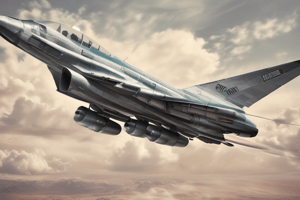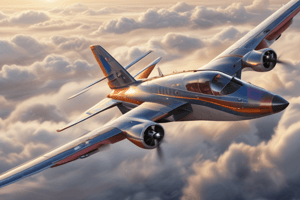Podcast
Questions and Answers
The upward force opposing weight is known as ______.
The upward force opposing weight is known as ______.
lift
The curved surface of the wing is called an ______.
The curved surface of the wing is called an ______.
airfoil
The angle at which the wing meets the oncoming airflow is known as the ______ of attack.
The angle at which the wing meets the oncoming airflow is known as the ______ of attack.
angle
According to Bernoulli's Principle, pressure is inversely proportional to ______.
According to Bernoulli's Principle, pressure is inversely proportional to ______.
Signup and view all the answers
The front of the wing is known as the ______ edge.
The front of the wing is known as the ______ edge.
Signup and view all the answers
Rotating air masses at the wingtips create ______.
Rotating air masses at the wingtips create ______.
Signup and view all the answers
A vertical extension at the wingtip is called a ______.
A vertical extension at the wingtip is called a ______.
Signup and view all the answers
Study Notes
Aerodynamics of Flight
Four Forces of Flight
- Lift: upward force opposing weight, created by wing shape and airfoil
- Weight: downward force, opposing lift, resulting from aircraft mass
- Thrust: forward force, opposing drag, generated by propellers or jets
- Drag: backward force, opposing thrust, resulting from air resistance
Wing Aerodynamics
- Airfoil: curved surface of wing, deflecting air downward to create lift
- Cambered: curved upper surface, increasing lift
- Symmetrical: flat upper surface, used for high-speed flight
- Angle of Attack: wing's angle relative to oncoming airflow, affecting lift and drag
Bernoulli's Principle
- Pressure: inversely proportional to airspeed
- Lift: created by lower pressure above wing, higher pressure below
Airfoil Components
- Leading Edge: front of wing, influencing airflow
- Trailing Edge: rear of wing, affecting lift and drag
- Chord Line: imaginary line connecting leading and trailing edges
Wingtip Vortices
- Wingtip Vortices: rotating air masses at wingtips, creating drag
- Winglet: vertical extension at wingtip, reducing vortices and drag
Four Forces of Flight
- Lift is an upward force that opposes weight, created by the wing's shape and airfoil.
- Weight is a downward force that opposes lift, resulting from the aircraft's mass.
- Thrust is a forward force that opposes drag, generated by propellers or jets.
- Drag is a backward force that opposes thrust, resulting from air resistance.
Wing Aerodynamics
- An airfoil is the curved surface of the wing that deflects air downward to create lift.
- A cambered airfoil has a curved upper surface that increases lift.
- A symmetrical airfoil has a flat upper surface, used for high-speed flight.
- The angle of attack is the wing's angle relative to oncoming airflow, affecting lift and drag.
Bernoulli's Principle
- Pressure is inversely proportional to airspeed.
- Lift is created by lower pressure above the wing and higher pressure below.
Airfoil Components
- The leading edge is the front of the wing, influencing airflow.
- The trailing edge is the rear of the wing, affecting lift and drag.
- The chord line is an imaginary line connecting the leading and trailing edges.
Wingtip Vortices
- Wingtip vortices are rotating air masses at the wingtips that create drag.
- A winglet is a vertical extension at the wingtip that reduces vortices and drag.
Studying That Suits You
Use AI to generate personalized quizzes and flashcards to suit your learning preferences.
Description
This quiz covers the fundamental principles of aerodynamics, including the four forces of flight (lift, weight, thrust, and drag) and the aerodynamics of wings, including airfoil and cambered surfaces.




